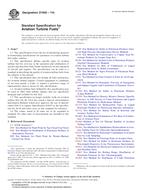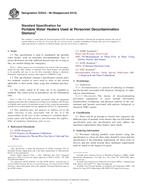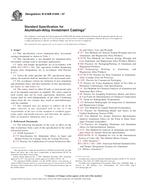1.1 This practice involves calculation of the thermal diffusivity from measured values of the mass density, thermal conductivity, and specific heat at constant pressure. It is applicable for any materials where these data can be determined. The temperature range covered by this practice is 20 to 300°C.
Note 1-The diffusivity, as determined by this practice, is intended to be a volume average value, with the averaging volume being [>=] 2 X 10 m (20 cm ). This requirement necessitates the use of specimens with volumes greater than the minimum averaging volume and precludes use of flash methods of measuring thermal diffusivity, such as the laser pulse technique. Note 2-This practice is closely linked to the overall test procedure used in obtaining the primary data on density, specific heat, and conductivity. It cannot be used as a “stand alone” practice because the thermal diffusivity values calculated by this practice are dependent on the nature of the primary data base. The practice furnishes general guidelines but cannot be considered to be all-inclusive.
1.2 The practice is intended to apply to isotropic samples; that is, samples in which the thermal transport properties do not depend on the direction of heat flow. If the thermal conductivity depends on the direction of heat flow, then the diffusivity derived by this practice must be associated with the same direction as that utilized in the conductivity measurement.
1.3 The thermal conductivity, specific heat, and mass density measurements must be made with specimens that are as near identical in composition and water content as possible.
1.4 The generally inhomogeneous nature of geologic formations precludes the unique specification of a thermal diffusivity characterizing an entire rock formation. Geologic media are highly variable in character, and it is impossible to specify a practice for diffusivity determination that will be suitable for all possible cases. Some of the most important limitations arise from the following factors:
1.4.1 Variable Mineralogy -If the mineralogy of the formation under study is highly variable over distances on the same order as the size of the sample from which the conductivity, specific heat, and density specimens are cut, then the calculated diffusivity for a given set of specimens will be dependent on the precise locations from which these specimens were obtained.
1.4.2 Variable Porosity -The thermal properties of porous rock are highly dependent on the amount and nature of the porosity. A spatially varying porosity introduces problems of a nature similar to those encountered with a spatially varying composition. In addition, the character of the porosity may preclude complete dehydration by oven drying.
1.5 This standard does not purport to address all of the safety problems asssociated with its use. It is the responsibility of the user of this standard to establish appropriate safety and health practices and determine the applicability of regulatory limitations prior to use.
Product Details
- Published:
- 05/10/1996
- Number of Pages:
- 3
- File Size:
- 1 file , 47 KB


